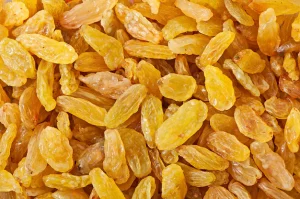It is common when you are eating raisins and Sultana you end up with an allergy or some react like skin rash. Raisins are a naturally delicious delicacy, but if you suffer an allergic response after eating the dried fruit, you might not find them to be very enjoyable.
Raisins are not often thought of as a frequent food allergy because they are manufactured from dried grapes; nonetheless, every food has the potential to set off an allergic reaction in certain people. According to the Cleveland Clinic, if you have an allergy to mold and consume raisins, you may experience an allergic reaction similar to the one you would get from the mold itself.
Schedule a consultation with an allergist so that you may find out what is triggering your symptoms. Your immune system may wrongly respond as though the proteins in raisins are dangerous if it fails to correctly recognize the proteins in raisins as being harmless.
This can result in an allergy to raisins. It is the job of the immune system to protect the body from foreign pathogens including viruses, bacteria, and poisons that might potentially cause illness.

Because your immune system misidentifies the proteins in raisins as potentially harmful, it produces disease-fighting molecules known as antibodies in order to eliminate the offending component. Immunoglobulin E is a kind of particular antibody that is created by the body in response to an allergic reaction to a meal.
These antibodies set off a chemical chain reaction throughout the body, which is responsible for the majority of the symptoms associated with allergic reactions. Once the allergen is determined, your doctor will advise avoiding it. You can take an over-the-counter antihistamine if you unintentionally eat raisins or mold spores. Painkillers, decongestants, and steroid creams are also used. Consult your doctor before taking any drugs.
With all the advantages of raisins but it may also cause allergies and the common one is skin rash. Raisins are not typically thought of as food allergens; nonetheless, they have been shown to cause allergic responses in the immune systems of some persons, particularly those who are sensitive to mold.
This takes place when a person’s immune system responds to the proteins included in raisins as if they were dangerous, rather than recognizing them as harmless. The following are examples of common allergic responses caused by raisins:
Increased likelihood of contracting bacterial infections:
1) A rise in histamine levels
2) Congestion in the nose
3) Runny nose
4) Difficulty with breathing
5) Wheezing
6) Coughing
7) Constriction in the chest
9) Rashes
10) Eczema

Having a rash as a sign of an allergic response to a meal is one of the more prevalent ones. The more you scratch at it, the longer it will last. This might also make you more susceptible to getting a skin infection. Your symptoms will begin to improve after your immune system has returned to normal. Some mild symptoms may be alleviated with the use of antihistamines and topical lotions.
In general, the rash should start to clear up within a day or two at the latest. According to the Food Allergy and Research Education organization (FARE), it is possible to experience the second wave of food allergy symptoms, which may develop up to four hours following the original response. However, this occurs very infrequently.
Make an appointment with your primary care physician if you believe the rash caused by your food allergy has developed into an infection. Inflammation, discomfort, and discharge are all possible symptoms of this condition. If the rash is infectious, it may become larger as a result of the infection.
Sultana allergy
As you are aware that some foods, fruit or even dried fruit such as Sultana and raisins can cause allergies in our body. While certain grape varietals could trigger an allergic reaction, others might not, depending on the individual. There are those who have a sensitivity to wine but not to grapes, while there are others who have an allergy to both grapes and raisins.
The symptoms of a raisin allergy are brought on by an increase in histamine levels in the soft tissues of the body. Antibodies called are responsible for communicating with white blood cells, which are found in soft tissue, and causing them to create histamine so the body may be protected.
Histamine promotes constriction of the pulmonary blood vessels as well as an increase in the production of mucus in the body. Because of these changes in the body, a person may have nasal congestion, a runny nose, watery eyes, difficulty breathing, wheezing, coughing, chest tightness, diarrhea, vomiting, nausea, stomach discomfort, skin rashes, eczema, hives, a change in heart rate, and lightheadedness.
In spite of the widespread production of grapes, which are of the Vitis vinifera species and belong to the Vitaceae family, a sensitivity to raisins is rather unusual. In adults has been linked to the eating of grapes, and other products made from grapes, although these cases are extremely rare and have been reported almost exclusively in Europe.

Even fewer case reports of grape exposure in youngsters have been found. We present the case of a child who was eight years old and who had nausea and itching of the mouth within a few minutes of consuming fresh raisins on many occasions.
It’s interesting to note that he can eat grapes. About the treatment, you need to visit your doctor and ask him about the remedy and avoid any home remedies to get rid of symptoms.
Mold allergy
Concerns linked to those who suffer from mold allergy:
Although mold allergies are rather prevalent, they are more commonly classified as hay fever or as an airborne allergies. Mold may be seen growing in a variety of different places, and it even grows on some dried fruits, including raisins.
If you are aware that you are allergic to mold, discuss the possibility of going on an elimination diet with your primary care provider. Because raisins may include mold, those who are sensitive to mold may be able to consume grapes but not raisins. This is due to the possibility that mold is present in raisins. In case you face a mold allergy, it’s necessary to know how to control the allergy.
Lotions and creams (also known as emollients) have the ability to alleviate itching and redness of the skin. Steroid medications, which include sprays, drops, creams, inhalers, and tablets, have been shown to be effective in reducing the redness and swelling caused by allergic reactions.
Immunotherapy is a treatment that may be advised for some individuals who suffer from extremely severe allergic reactions. This entails gradually exposing yourself to the allergen in a safe environment over the course of several years so that your body can adapt to it and reduce the severity of its reaction to it.
Asthma and eczema are two of the most common allergens, although it’s not obvious why this occurs. Most persons affected have a family history of allergies or similar illnesses, such as asthma.

Every year, the number of persons with allergies grows. It’s unclear why this is happening, but one popular theory is that living in a cleaner, germ-free environment has less impact on our immune systems. When it comes into touch with innocuous compounds, this may make it respond in a way that might be dangerous.
Grape allergy
An allergy to grapes can induce symptoms that are similar to those caused by other allergies. Coughing, rashes, wheezing, a runny or stuffy nose, and asthma are some of the symptoms that have been linked to grape allergies.
Oral allergy sufferers may have symptoms such as swollen lips, throat, and areas surrounding the mouth; itching in the throat; and irritation of the gums or eyes. The signs and symptoms of anaphylaxis include low blood pressure, hives, face swelling and swelling of the throat, trouble breathing, or wheezing.
It is possible for children to acquire an allergy to grapes, despite the fact that they are not among the “top eight” allergens like milk, wheat, and nuts, which are more commonly associated with allergic reactions. However, it’s possible that your child doesn’t have an allergy to grapes but rather a response to other compounds that are on the grapes.
Visit your kid’s primary care provider for allergy testing if you have any reason to believe that grapes were the cause of the response your child had. There is also the possibility of adverse interactions with other meals.

Allergic responses are brought on by the proteins found in food. Grapes are not typically thought of as a food that includes protein; one cup of grapes contains 1.09 grams of protein, which is sufficient to trigger an allergic reaction in some people.
There are three proteins in particular that are suspected to be responsible for the allergic reaction to grapes. These proteins include a grape lipid transfer protein, an endochitinase 4A protein, and a thaumatin-like protein.
According to a study, LTP is the primary protein allergen that may be found in grapes. People who are allergic develop antibodies that release molecules that fight the allergen, and their immune system of them responds to innocuous proteins found in meals.










Your comment submitted.